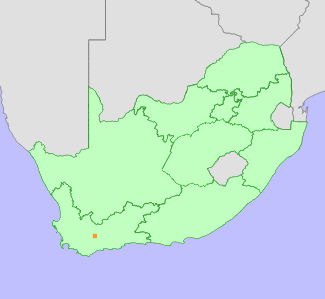|
Scientific Name | Euryops dasyphyllus Vlok |
Higher Classification | Dicotyledons |
Family | ASTERACEAE |
National Status |
Status and Criteria | Critically Endangered B1ab(iii,v)+2ab(iii,v) |
Assessment Date | 2022/06/29 |
Assessor(s) | J.H. Vlok & H. Mtshali |
Justification | This range-restricted species has an extent of occurrence (EOO) of 4 km² and is found in Ladismith district, Western Cape. It was known from two subpopulations, but one has been lost due to ploughing. The remaining subpopulation continues to decline due to ongoing habitat degradation as a result of overgrazing and drought. It is therefore listed as Critically Endangered under criterion B. |
Distribution |
Endemism | South African endemic |
Provincial distribution | Western Cape |
Range | This species has a restricted distribution range in the Ladismith district, in the Western Cape Province of South Africa. |
Habitat and Ecology |
Major system | Terrestrial |
Major habitats | Western Little Karoo |
Description | It is found in dry, clayey soil with calcrete and quartz pebbles, at 650 m. |
Threats |
| Only two subpopulations of this species are known; the one subpopulation where the type collection was made was severely disturbed in the 1990s when the area was ploughed to establish Old-man Saltbush. No plants have been found at this site, and the subpopulation is now extinct. The remaining extant subpopulation occurs within the Anysberg Nature Reserve, where there are high concentrations of game species, especially in Eland, where the plants occur. Since this species is palatable, it is declining due to the impacts of grazing. There have also been a number of years of below-average rainfall experienced since 2015, and the population is also likely to have declined due to drought. |
Population |
This species has a very limited distribution range. It was known from two subpopulations: one suspected to originally have had fewer than 1000 individuals was lost to ploughing in the 1990s, and the remaining subpopulation suspected to have around 4,000 plants is currently declining due to grazing and the impacts of drought. Urgent monitoring efforts are required to establish the current size of the population.
|
Population trend | Decreasing |
Bibliography |
Vlok, J.H.J. 2020. Three new species and one new subspecies of Euryops (Asteraceae: Senecioneae) from the Klein Karoo in the Western Cape Province, South Africa. South African Journal of Botany 133:167-173.
|
Citation |
| Vlok, J.H. & Mtshali, H. 2022. Euryops dasyphyllus Vlok. National Assessment: Red List of South African Plants version 2024.1. Accessed on 2025/11/11 |
 Comment on this assessment
Comment on this assessment

